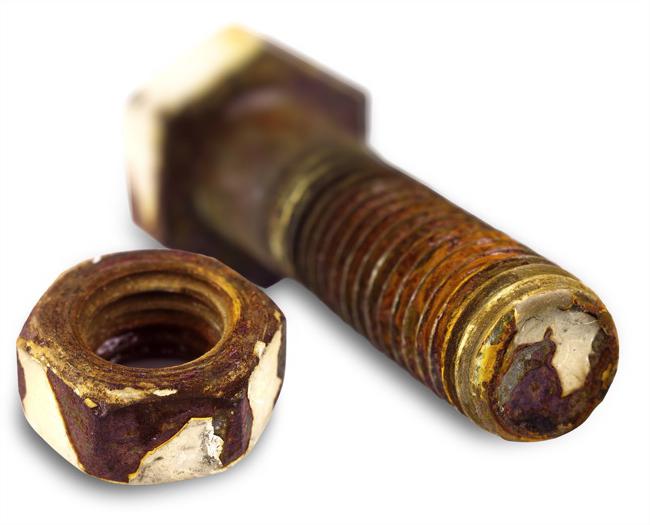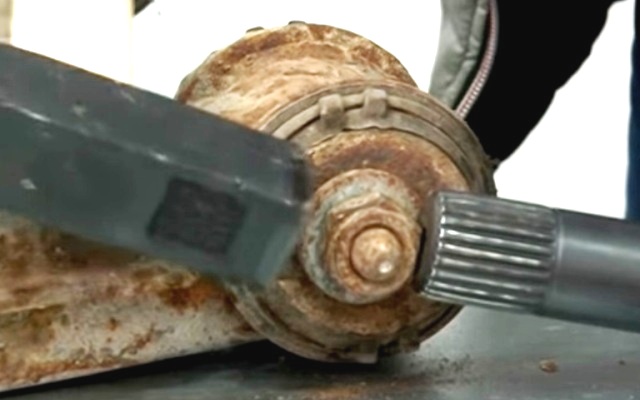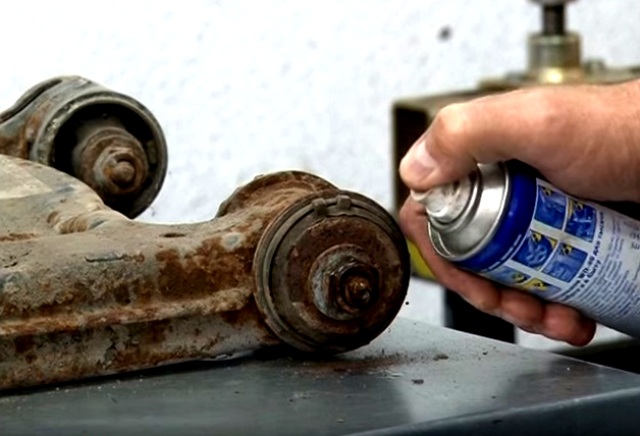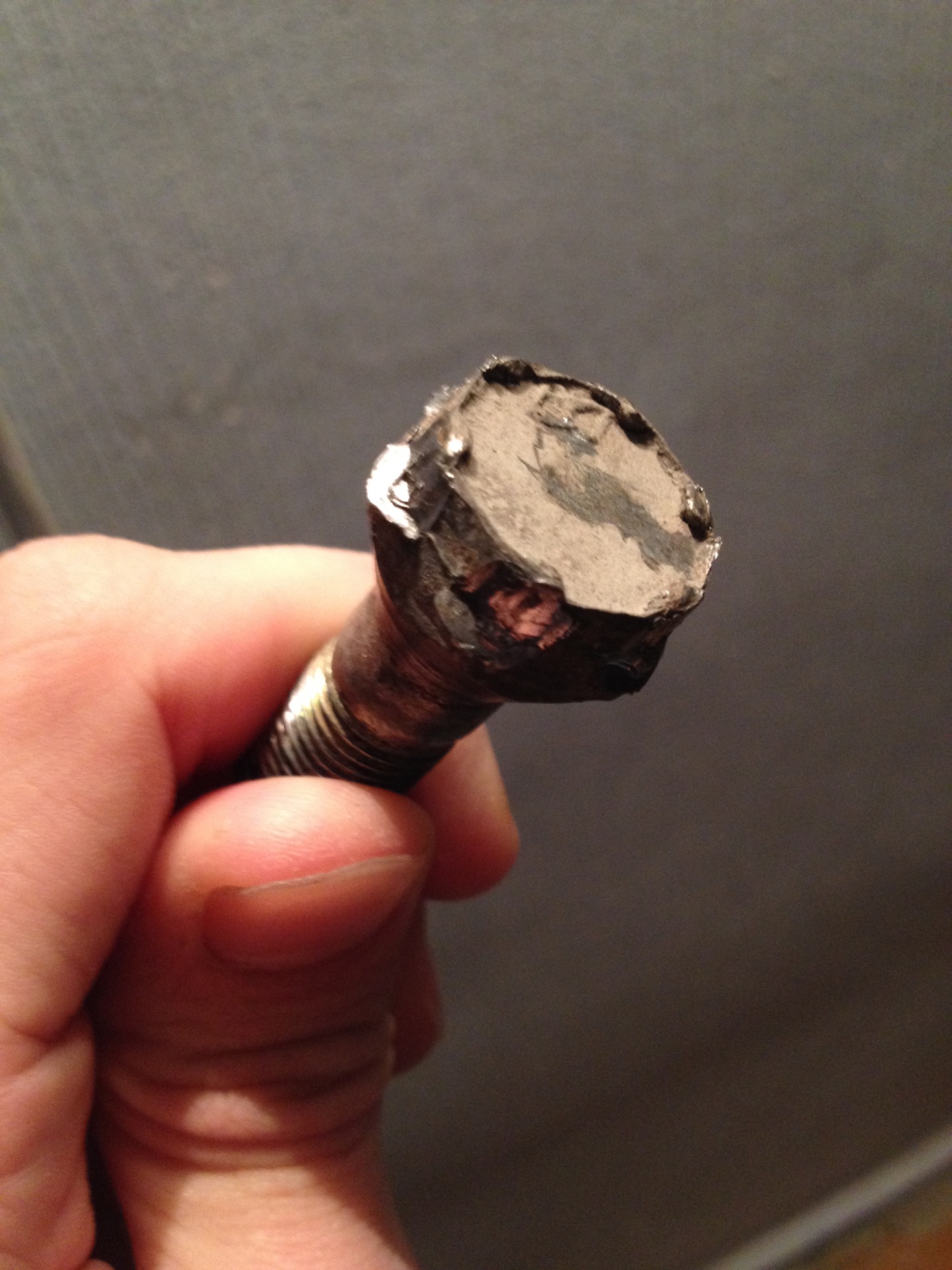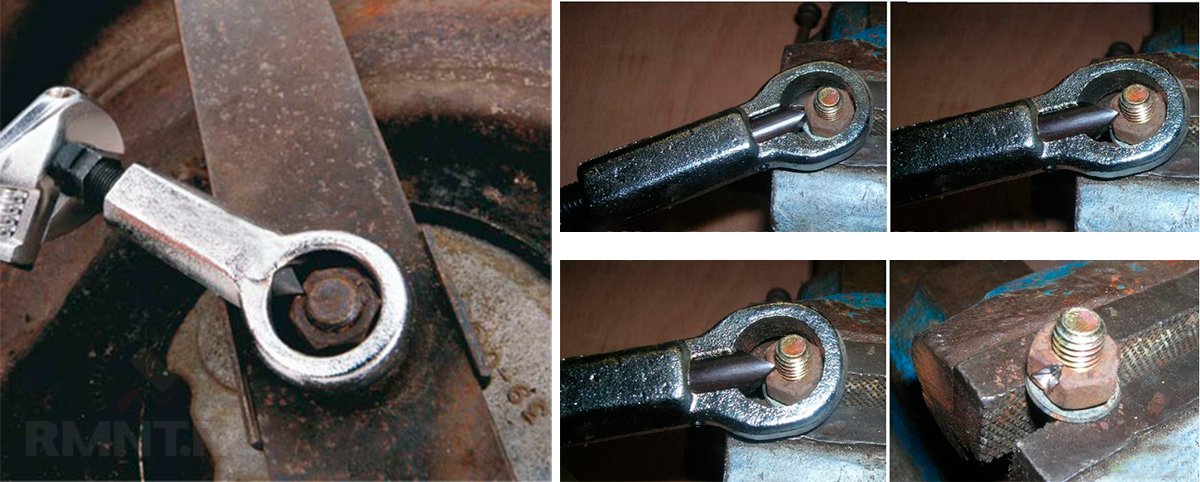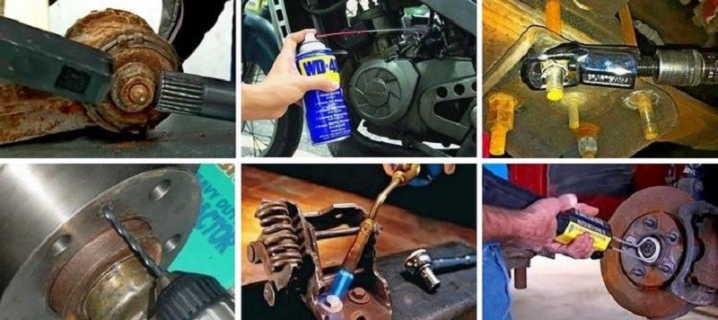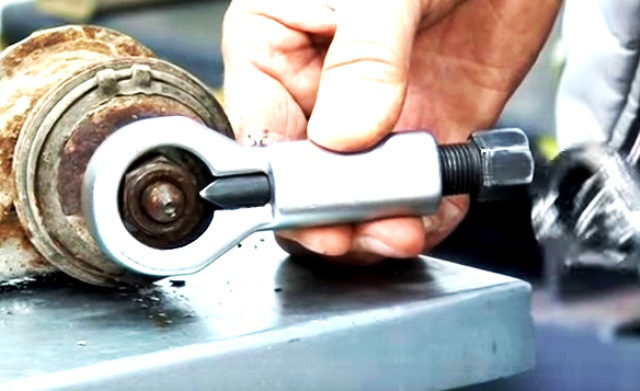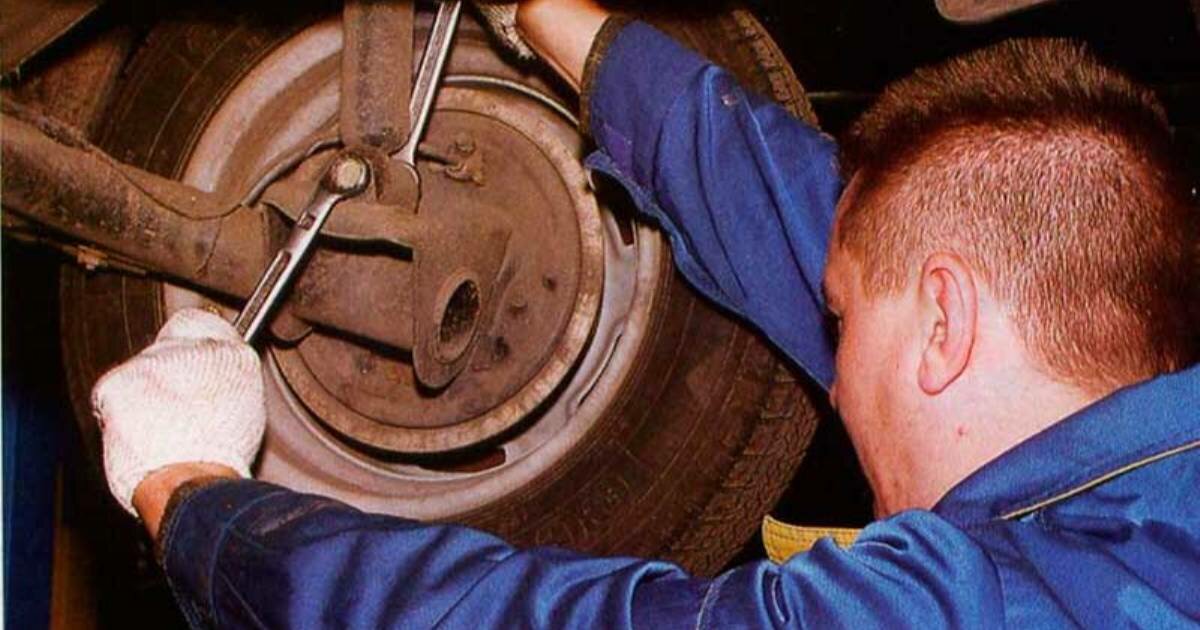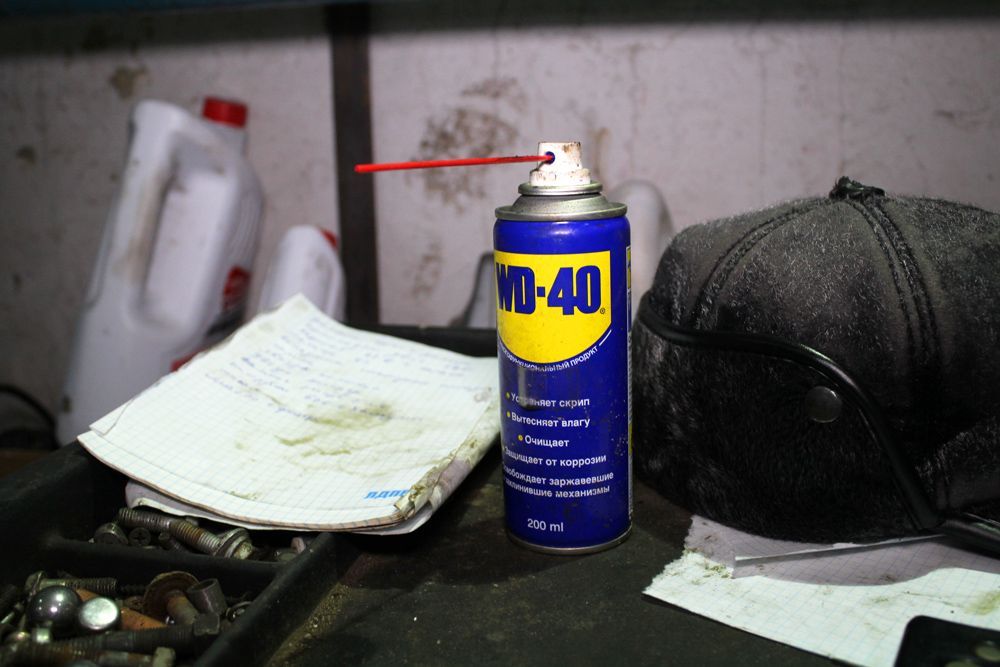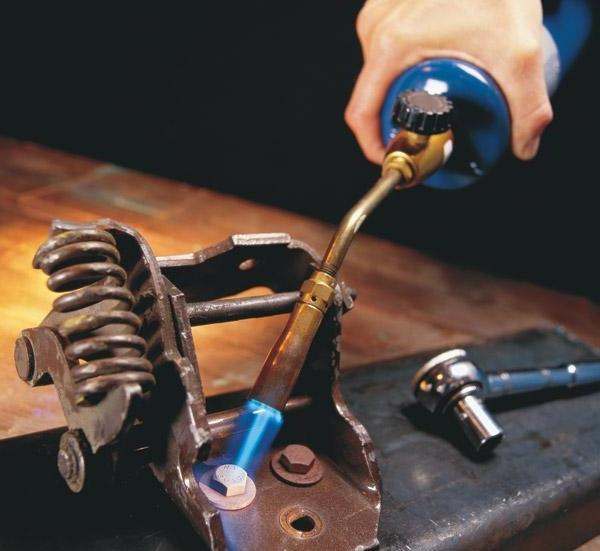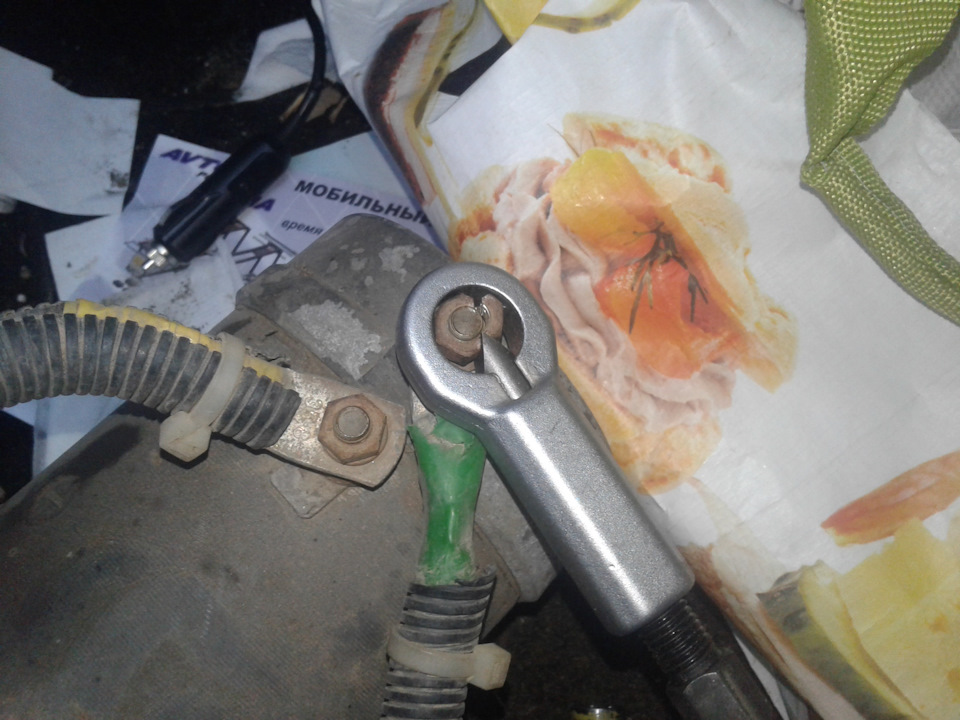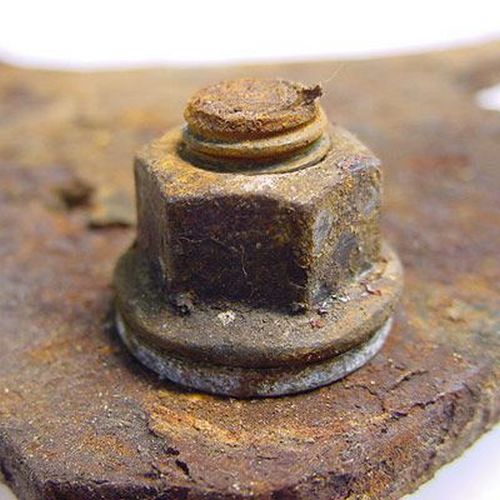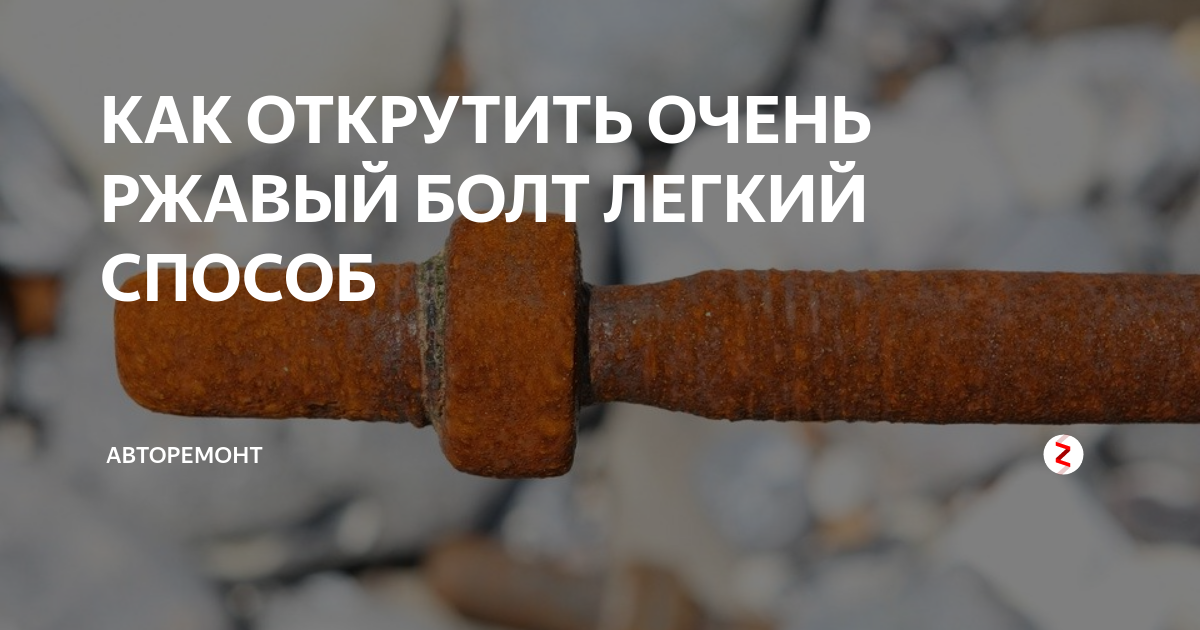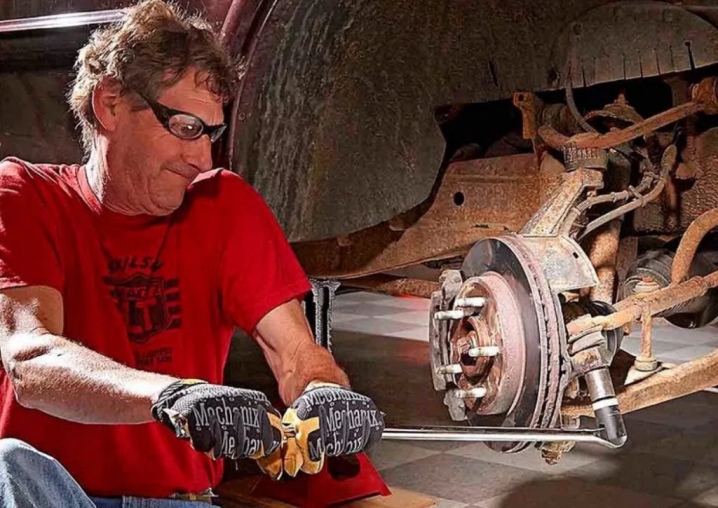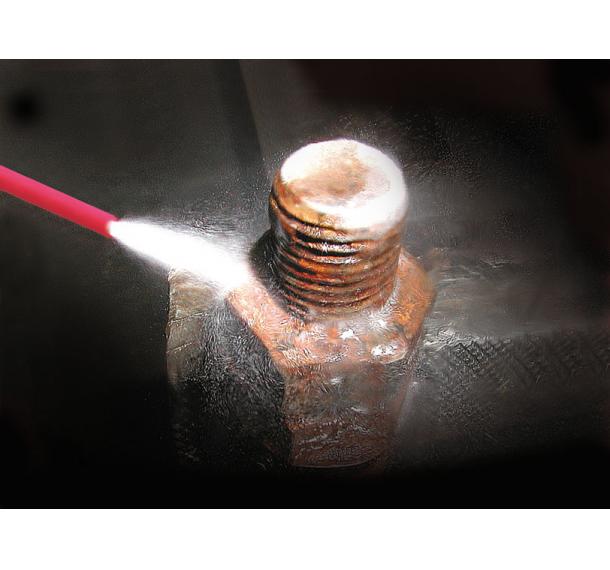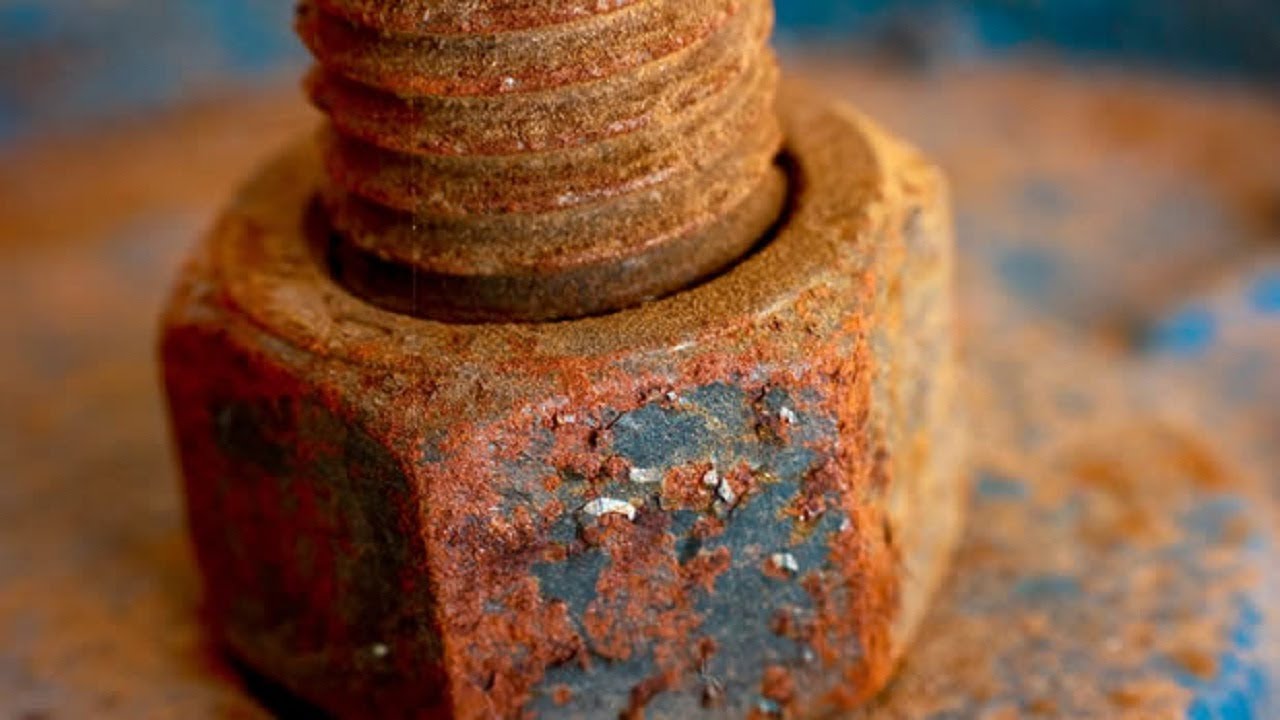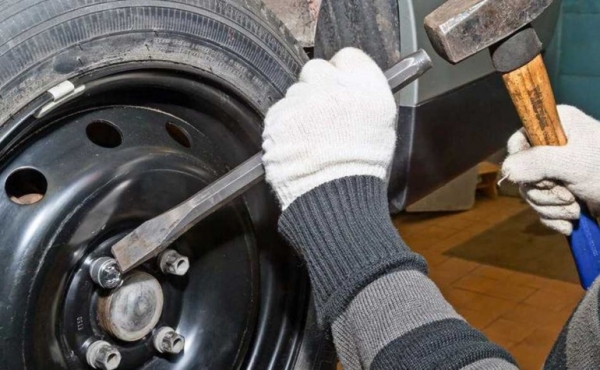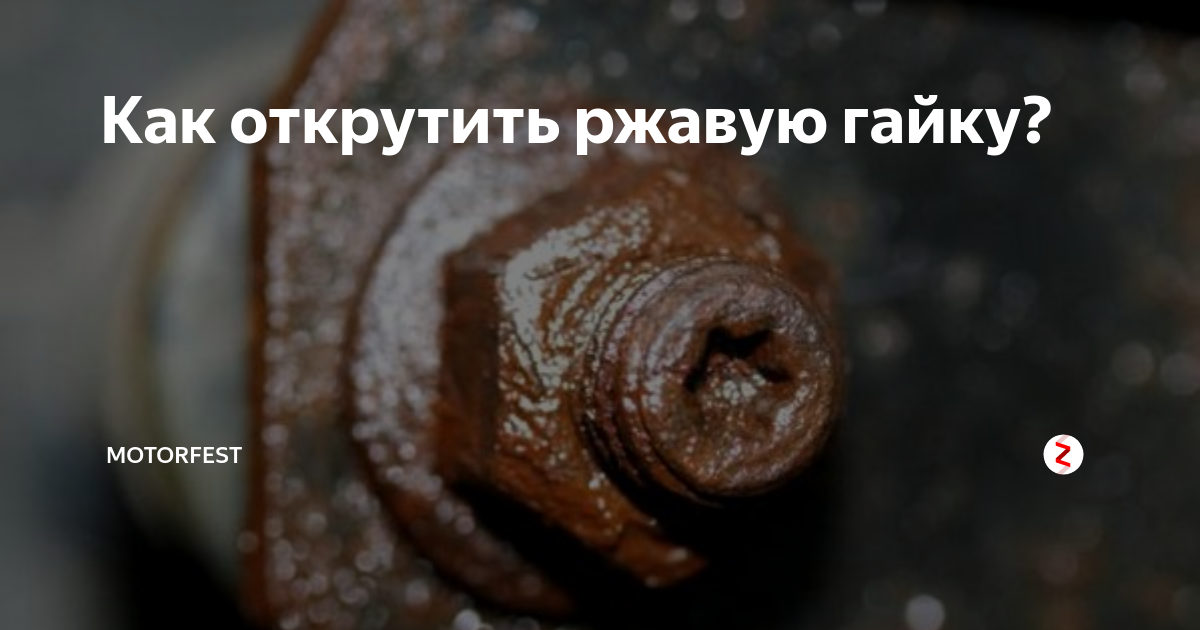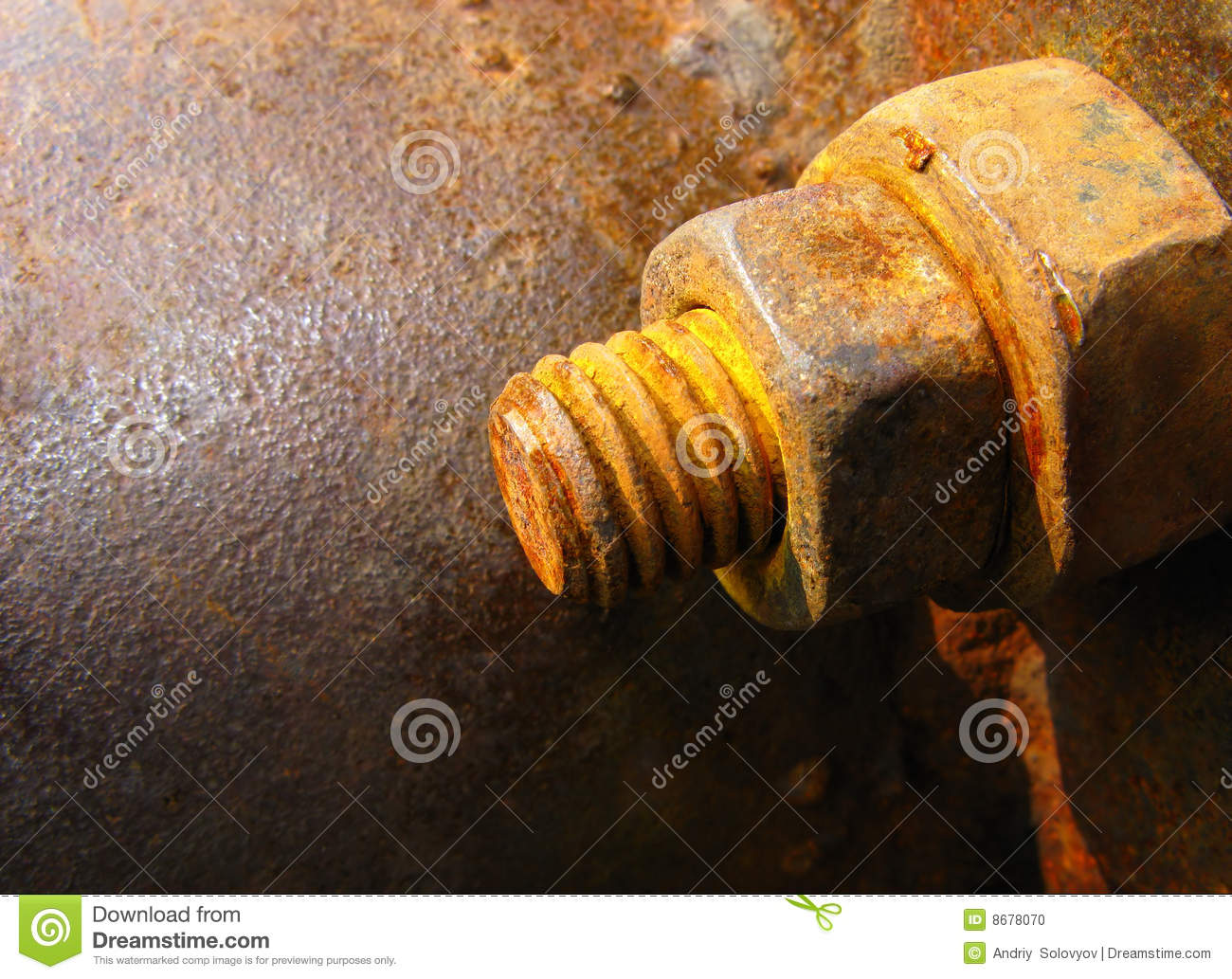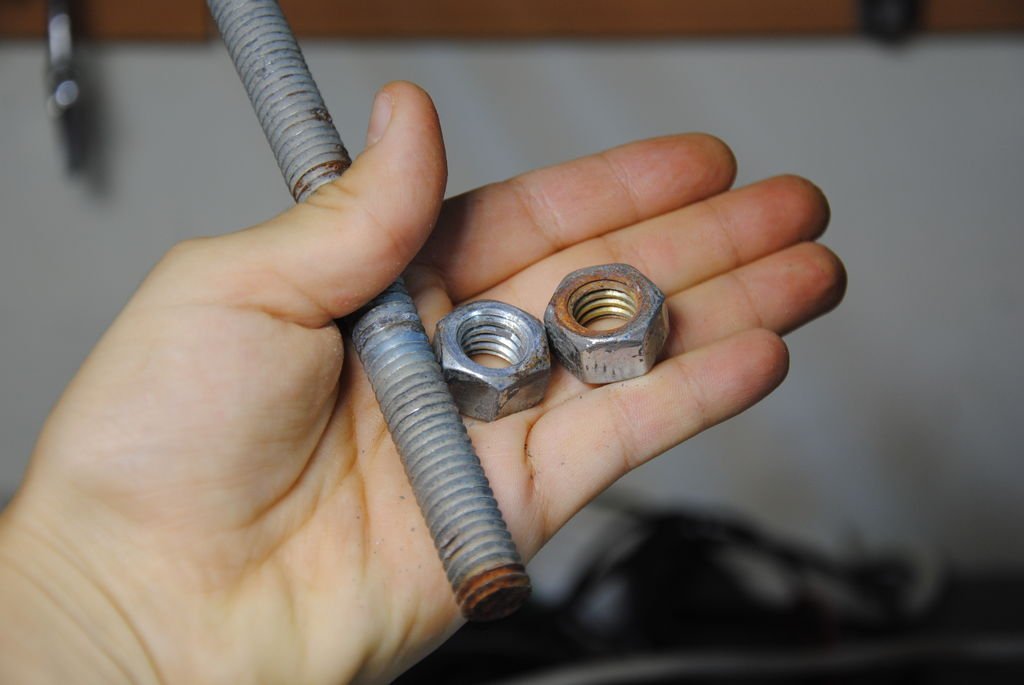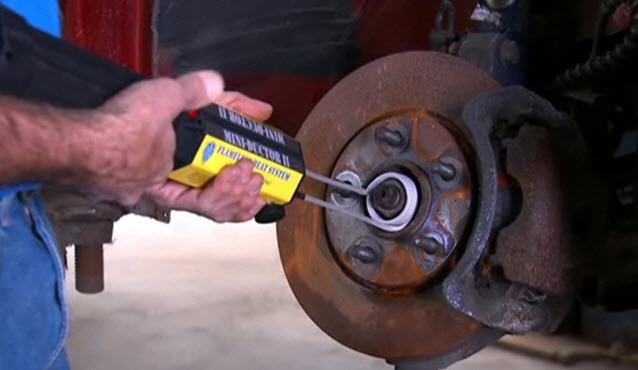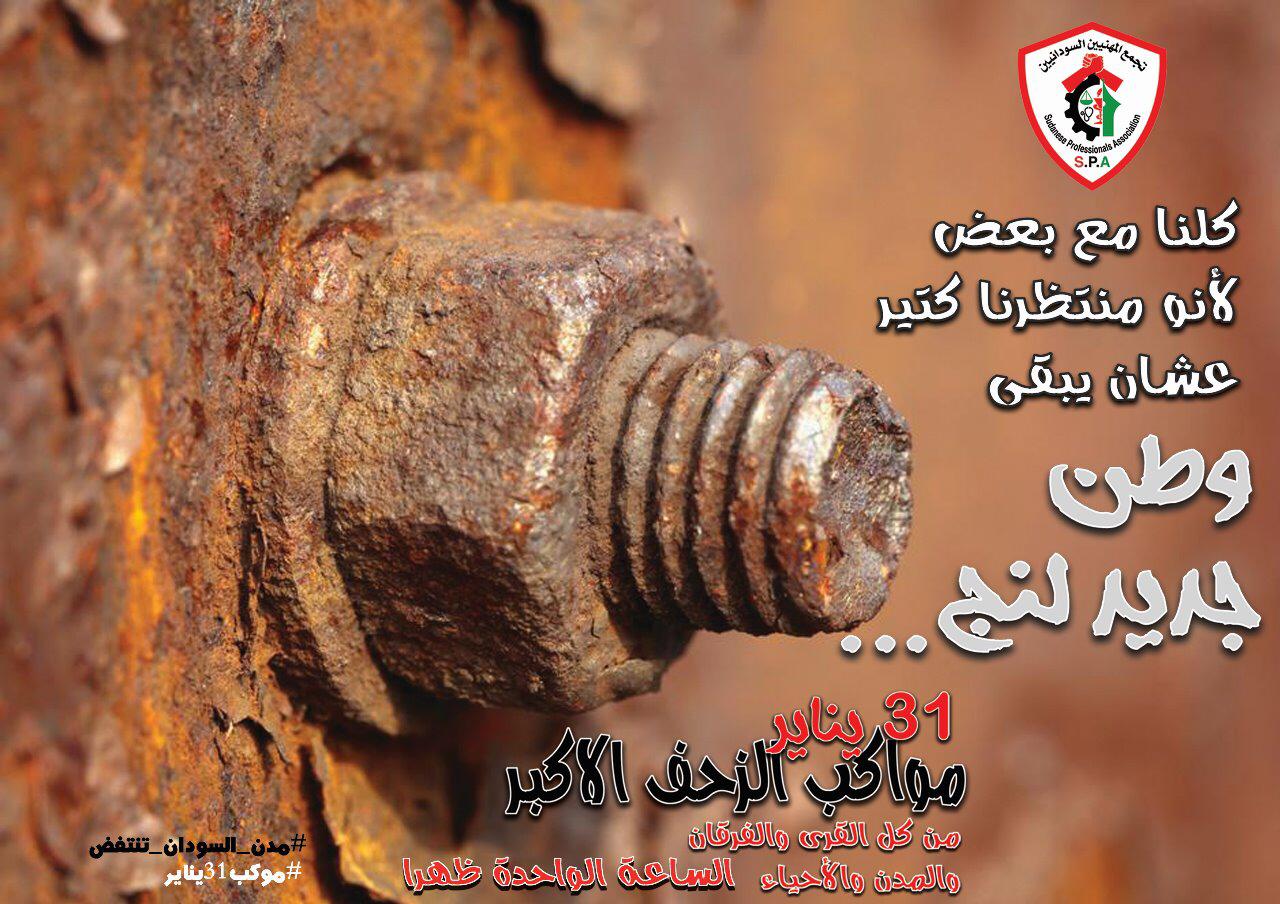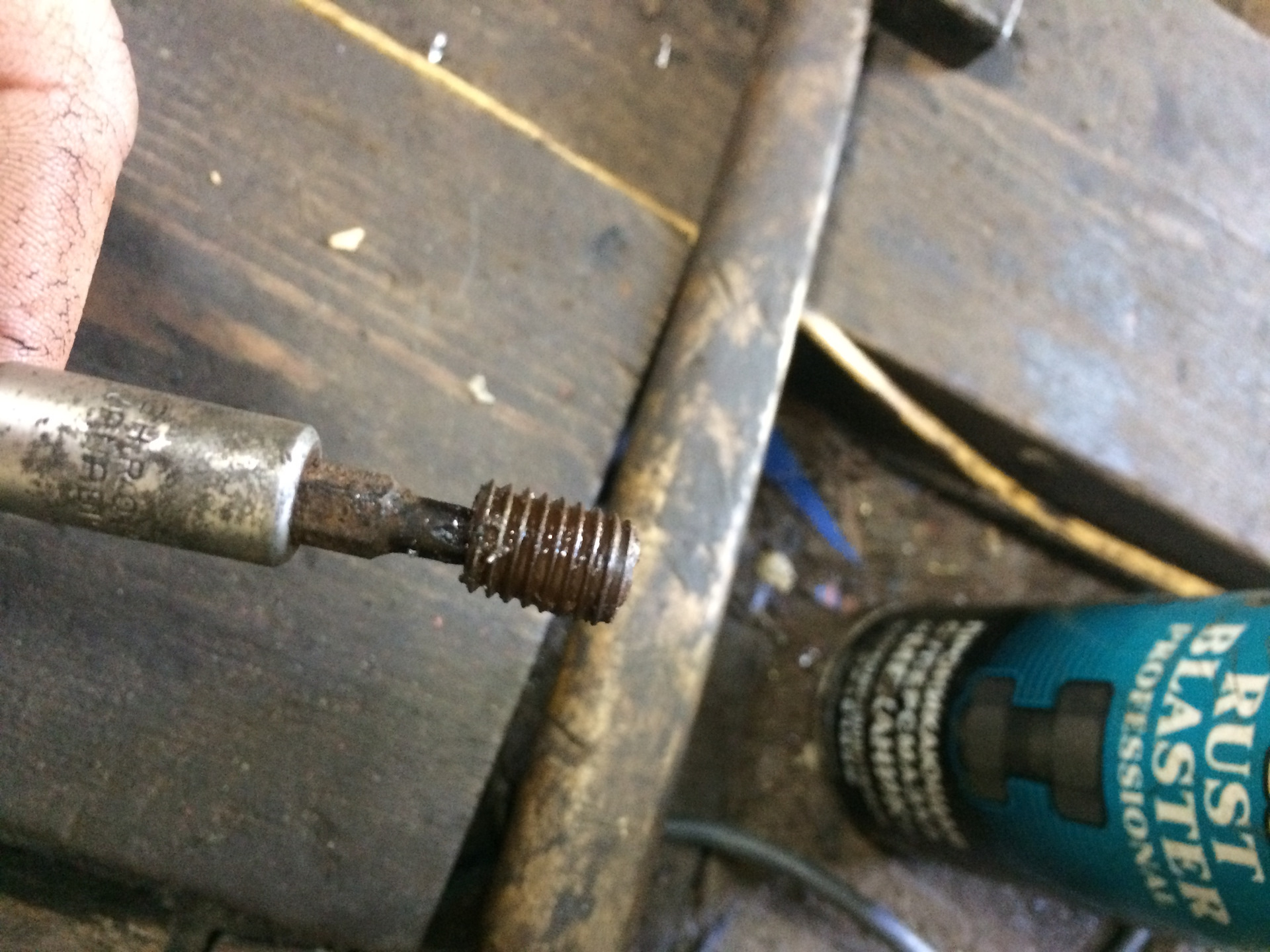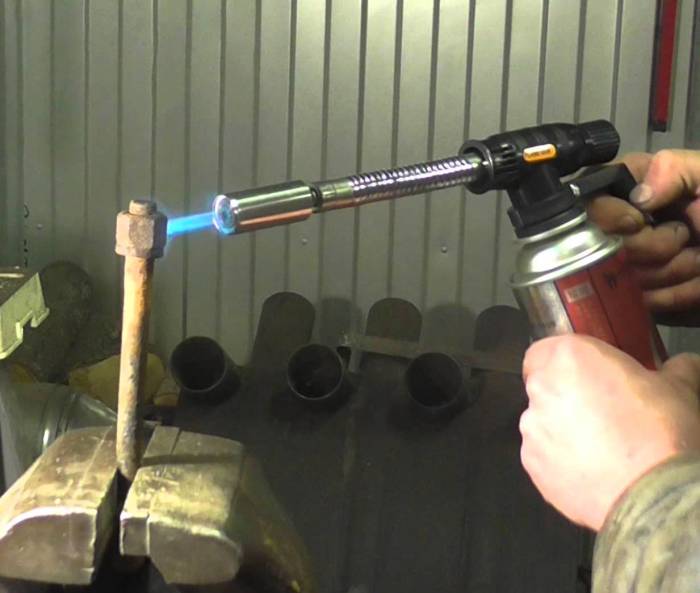Ways to disassemble threaded connections at home
There is a whole set of popular ways of how to unscrew a stuck nut. But the first time does not always work, you have to tinker. Unscrewing a rusted bolt is not so easy. But with experience comes skill, when rust on the fasteners no longer scares. There is no universal way, each specific case requires an individual approach.
Warming up
Plumbers like to use this method, who always have a gas welder in the brigade. The problematic connection is heated with a gas burner. In this case, the nut increases in size due to thermal expansion. The thread also weakens. It becomes easier to unscrew the hardware.
But this method does not always work. Then the capricious unit continues to heat up further. As the temperature rises, when the bolt heats up together with the nut, rust begins to burn out, freeing the thread. If the old fastener is supposed to be used further, it is necessary to unscrew it only after it has cooled down.
These methods, as life has shown, are very effective, but not every home craftsman has a gas burner, so you have to resort to other methods. For example, perform heating with a blowtorch or a hot air gun.

Tapping
One of the oldest methods is to tap the threaded joint with a hammer. Shocks generate vibration that can crack and peel off the rust. In advanced cases, this is unlikely to work, but if corrosion processes have begun recently, it is quite possible to disassemble the connection.
Welding
An effective method is to weld a larger nut to the head of the bolt. For example, if the rusted hardware has an M16 thread, then an M24 nut attached to it by welding will allow you to take a more powerful wrench and extension cord for work. The effort is less significant due to the increase in the lever.
Jerking off
You can move the fasteners from their place with a sharp jerk of the key. It is better to use an extension cord. If the first attempt does not work out, they try to move in the opposite direction - for twisting. Then these two steps are repeated.
This method is called loosening and in some cases it helps. Especially if the assembly is pre-lubricated with a suitable agent and kept for several hours.
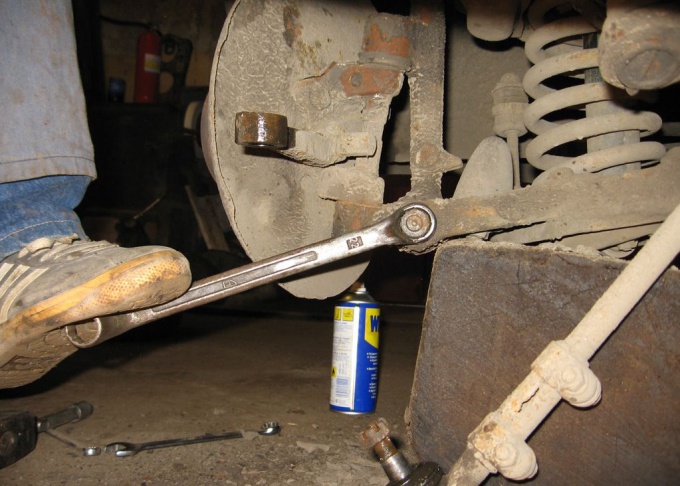
Popular lubricants and solvents
To facilitate the work of loosening stuck nuts and bolts, many craftsmen use various chemical fluids. Pre-wetting the problem site greatly facilitates the task.
To do this, you can use:
- kerosene;
- petrol;
- alcohol;
- iodine;
- table vinegar;
- carburetor cleaner;
- brake fluid;
- WD-40 tool.
Even Coca-Cola will do. The rusted place is lubricated with liquid with a brush, but even better - moisten a rag with a means and wrap the fasteners, leaving it for at least two hours, preferably for a day. The exception is WD-40. It is simply sprayed onto the rust from a can. Having withstood the time, they are trying to unscrew the hardware. In most cases, the attempt is successful.
If the result is negative, any acid can be used. To do this, from beeswax or plasticine around a rusty nut (bolt), a cup is molded with a height a little more than hardware. Acid is poured there and a piece of zinc is put. The result is a galvanic pair. Acid destroys rust, and zinc reduces iron cations.
This method allows you to untwist the knot without damaging the parts with acid, but it is applicable only if the fasteners are located vertically in the upper position.

How to unscrew a torn off bolt?
Basic methods:
- The surface is cleaned with a metal brush and treated with diesel fuel or kerosene. They try to unscrew the nut with a spanner wrench. Although there is no 100% guarantee that it will unscrew.
- With the help of a chisel and a hammer, blows are applied in the direction of unscrewing. This method will not work for a small nut.
- A gas wrench with a powerful clamp is a good tool in this situation. It is easy for them to grasp even round objects, but harder in hard-to-reach places. The longer the handle, the easier it is to unscrew.
- When the fastening material is large and difficult to unscrew, it is possible to apply a metal coating using welding equipment and prepare the desired turnkey shape with a file.
- A hole is cut out with a drill inside the body of the fastener, an L-shaped rod is threaded through it, which will serve as a handle, and removed.
When there is enough room to use a monkey wrench or pliers, this is good, but what to do in other situations?
How to remove a hex head bolt or sprocket
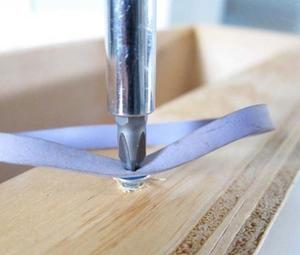 To remove the element, a gas wrench is used with a part crimp, a cut is made on the head with a grinder and unscrewed with a screwdriver, an extractor of the appropriate size, special tools (wrench, hairpin), which are beneficial to purchase only if such problems have to be encountered quite often.
To remove the element, a gas wrench is used with a part crimp, a cut is made on the head with a grinder and unscrewed with a screwdriver, an extractor of the appropriate size, special tools (wrench, hairpin), which are beneficial to purchase only if such problems have to be encountered quite often.
The TORX sprocket is selected by size (it should not be large and slot into the hole for the hexagon). It is inserted tightly into the cap and the bolt is unscrewed with a jerk, in order to avoid disruption of the sprocket spline. Driving sprockets with holes in the center breaks them off and is therefore not recommended.
In any construction and auto shop, extractor sets are sold. Outwardly, this device looks like a metal rod with a tapered thread on the left side and a faceted base on the right. With their help, the nuts with the torn off edges are unscrewed. To do this, a hole is drilled strictly in the center of the bolt, an extractor of the required size is hammered into it and unscrewed with pliers. This is done simply and quickly, because the extractor has the opposite cut.
A reversible drill is an irreplaceable thing. Make a hole at the bolt with a thin drill. Take a left-hand drill with a smaller diameter and drill out the damaged bolt in the inverse rotation mode.
Methods for loosening sour bolts
Car enthusiasts, namely, they most often have to deal with stuck bolts, know how to unscrew a sour bolt. Several methods of loosening are used, including the use of physical and temperature exposure, chemical compositions.
Tapping and physical impact
Impact with a hammer and chisel helps to break the adhesion of materials, corrosion, as a result of which the bolt yields and twists out.

Tapping. A preparatory measure that helps break down oxides. In mild cases, after tapping, it is possible to unscrew the hardware. It is enough to hit the fastener 2-3 times with a hammer using a copper adapter.
Loosening. Like tapping, it is aimed at breaking down rust. You should not unscrew, but on the contrary, tighten the bolt even tighter, and only then try to unscrew.
Lever arm. It is advised to use it as a key tool at hand. First, the hardware itself and the area around it should be cleaned with a metal bristle brush. Then a spanner wrench is put on the head of the fastener, and a pipe is put on the wrench. The lever increases the force of impact, but it is not recommended to apply excessive force, as this leads to licking the edges of the nut and breaking the key.
Chisel. Using this effective technique, rust can be broken up and fasteners can be lifted off the ground.
However, in this case, it is important how the chisel is installed.It should be placed closer to the edge of the bolt / nut, at an angle, in the direction of unscrewing
The blunt side of the chisel should be hit hard and hard with a hammer.
WD-40 and Penetrators

WD-40 is a popular tool used by almost all motorists. If suddenly it was not at hand, other liquids, such as gasoline, kerosene, white spirit and the like, will help unscrew the bolt due to the high penetrating power and properties of the solvent. They soften dirt, rust, penetrate deep into the threads, acting as a lubricant. The application is simple: you need to clean the area around the acidified compound and fill it with the selected agent. After 10-15 minutes, the deposits will soften, the grease will seep into the smallest gaps - the bolt can be unscrewed.
Warming up

Under the influence of high temperature, the metal expands, therefore, in order to unscrew the bolt, you need to warm up the nut or the part into which the hardware is screwed, and if this does not help, then the fastener itself, since the fluctuation in size will help destroy the rust. It can be heated with a tool such as a gas torch, a soldering iron, or even a lighter.
A special device for heating corroded and stuck bolts and nuts is an induction bolt heater. The heated part is placed inside the induction field, the spiral, and as a result heats up. The advantage is that heating is carried out from all sides at once, and not from one side, as in the case of using a burner or other tool. This device is small, convenient, operates on a 220 V network. You can assemble it yourself from available tools.
While the nut is hot, unscrew it with an open-end wrench or socket wrench. If it was not possible to unscrew it immediately, repeat the procedure and use combined methods (lever, tapping, loosening).
Acids

Acids are used to loosen bolts and nuts. A well-known remedy is table vinegar. After moistening the cleaned compound with vinegar or covering the rusted area with a rag soaked in vinegar, wait about 30 minutes for the rust to soften. Then the hardware can be twisted.
In addition to vinegar, phosphoric acid is used, and in particular Coca-Cola, which contains it in an amount sufficient for a positive result. The procedure remains the same: it is necessary to clean the area surrounding the fastener and fill the fastener with a drink. He should get wet. Periodically, they try to unscrew the bolt. Phosphoric acid is used to degrease and dissolve rust.
A special agent that is made on the basis of acids is a rust converter. Before using it, the surface must be cleaned and degreased with a solvent. Then a small cloth is moistened with the converter and placed directly on the rusted joint. Rust is destroyed - the hardware is unscrewed.
Why is a rusty nut difficult to unscrew
The main culprit for poorly loosening nuts is rust. This is one of the types of corrosion that appears on the surface of iron. The reason for such formations is the reaction of the metal with oxygen in a humid environment.
In the process of corrosion formation, there is a manifold increase in the oxidation product (rust). As a result, the nut and bolt merge tightly together. The acidification of metals can be so strong that when you try to turn the nut, it will be easy to break the bolt.
Another culprit for poorly loosening nuts is contamination. Small particles of metal shavings and dust remain on the thread surface. When the nut is tightened, dirt becomes an additional obstacle. As a result, the threaded surfaces of the bolt and nut become jammed.
The third reason is that the nut is too tight. Some novice locksmiths tighten the nut almost with their foot.A little time passes, the tightly clamped metal surfaces stick to each other, aggravating the situation. As a result, a tightly tightened nut cannot be unscrewed.
And the last reason for failed attempts to turn the nut is a poor-quality tool. In the course of long-term use, the edges of the keys are deformed or grinded. With a damaged tool, it becomes difficult to grasp the nut and pull it off the thread.
Bolt shearing

Often the descent / camber adjusting bolts sour. The fact is that they must be lubricated not only with each camber adjustment, but also at zero maintenance. If this is not done, the bolts will turn sour. A layer of aluminum oxide can be found on the unscrewed bolts. It happens that the nut unscrews more or less freely, and the bolt rotates together with the silent block and the lever, i.e. the bolt will sour precisely in the inner sleeve of the silent block. In this case, you can:
- Heat up - the success of this event is not guaranteed, by the same time you will have to spend a lot.
- Fill it with a "vedehkoy" - if the bolt in the bushing has not soured too thoroughly, this method will help to unscrew it. If necessary, you can leave the bolts overnight or overnight to soda. Then they should be warmed up. After that, they are usually unscrewed.
- Use a construction puncher. First unscrew the nut and remove the washer. Then screw the nut flush with the bolt. A head of the appropriate size is put on the nut. Then, having inserted a pike into the punch, and the pike itself into the head, the punch is turned on in the impact mode. From the effects of vibration, the bolts are knocked out and subsequently they can be unscrewed.
- The last way is to saw the bolt in the silent block with a grinder, but there is a risk of damaging the subframe. If you remove the stretcher, then this work is very time consuming and expensive.
The work is done step by step as follows:
Having installed a jack and placed some supports under the car for reliability, they remove the wheel, fist and start work
Cutting must be done very carefully so as not to saw through the subframe.
Having cut off the lever and the eyelet, pull it out from the inner sleeve of the silent block. It is more difficult to cut the inner sleeve with the bolt than the lever, since they are recessed into the subframe and it is difficult to get to them with a grinder.
When the bolt has already been cut, it may turn out that its parts cannot be removed due to the sour bushing
In this case, it is recommended to heat the parts of the fastener and help with a chisel and hammer, knocking on the sleeve.
Naturally, with this type of repair, it is required to purchase new levers and bolts in advance. When doing work with your own hands, you will have to spend only on components. However, it is not recommended to undertake this work without proper skills in working with a grinder. Before embarking on a radical method, experts still advise trying out conservative and less expensive methods.
Sour bolts are a headache for motorists. It takes time to unscrew them, but if you know in what ways you can unscrew the bolt, then the result of the work will be positive.
Previous Post Bolt and screw: what's the difference
The next entry How to unscrew a broken bolt from the engine block
How to destroy the structure of corrosion
Before trying out the methods below, we strongly recommend that you use a friction reducing agent. The most suitable (and most commonly used) option is WD-40. Among the available tools are suitable:
1) Turpentine; 2) Gasoline; 3) Kerosene; 4) Diesel fuel.
You can use a weak acid (acetic acid is suitable). Moisten the rusty compound with the chosen agent and leave for 10-25 minutes (this is necessary for the liquid to penetrate deeply inside). Now feel free to start unscrewing.
Method number 1.
Hammering
Gently tap each side of the nut (a lightweight 100g hammer is ideal for this).On impact, microdeformation occurs, which contributes to the destruction of rust. Your main task is not to overdo it: too strong blows will damage the edges of the nut (perhaps the bolt to which the nut is stuck) will bend. In parallel with this, regularly try to unscrew the nut.
Method number 2
... The heating
As you know, objects expand when heated. The expansion will cause significant corrosion damage, which will enable us to unscrew the rusted nut
... It can be heated using any heat source: a match, lighter, candle, blowtorch, boiling water, a hair dryer, a gas burner, etc. Be extremely careful when heating! There should be no flammable objects nearby.
However, this method has two nuances:
1) It should be unscrewed extremely quickly, until the bolt heats up; 2) The method will not work if paint and varnish or wooden coatings are present in the joint.
Method number 3.
Doing the opposite
Need to unscrew a rusty nut? Start spinning it. The "trick" of the action is that sometimes, with a slight additional twist, it turns out to destroy the corrosion structure and the nut will turn out to be unscrewed. The method can be associated with the first and second, in which case the stuck nut or bolt will almost completely lose ground.
Safety measures at work
Unscrewing rusted joints, as well as their destruction, requires compliance with safety precautions.
In order not to get injured during work, the following requirements should be strictly followed:
Use overalls and protective equipment: gloves, glasses.
The back of the chisel and the hammer head (sledgehammer) should not have rivets, wooden handles - cracks.
When working with a chisel, extreme care is required so as not to strike the finger.
It is strictly forbidden to use homemade pipe extensions for keys.
With great effort, they can burst, fly off, and the worker will be injured.
Acids should be handled with care to avoid burns. Protects the eyes and skin of the hands when working.
When working with a gas burner, use dark glasses, tarpaulin gloves and follow the rules for handling gas cylinders
Do not touch heated parts with bare hands.
When unscrewing the stuck and rusted fasteners, a stable posture is taken. You need to be prepared for the fact that the hardware can break off at any time. It is also possible that the key breaks down due to a hidden factory defect: hairline cracks or pores.
When working with one hacksaw blade, part of it, which will be taken by hand, is wrapped with electrical tape or a rag so that the teeth do not damage the skin.
When welding, be sure to use tarpaulin overalls, gloves, closed shoes, on which trousers are put on in order to avoid sparks from getting into boots or boots.
When working with chemical fluids, the room in which the work is performed must be well ventilated.
When using the grinder, you must wear vibration-damping gloves, goggles or a screen.
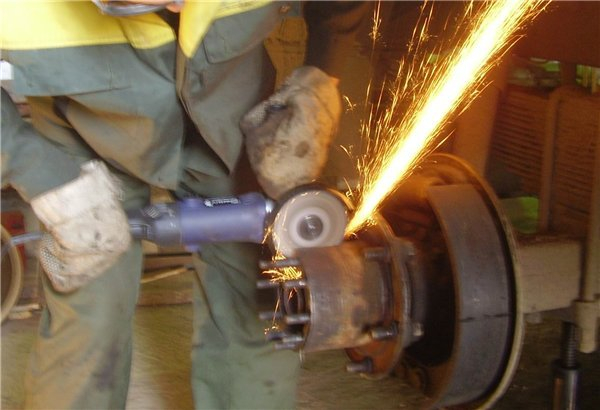
Unscrew the rusted screw
If You can not remove the rusted screw, then use the following methods. For example, tap a threaded connection with a hammer, while substituting a screwdriver from different sides. Due to this, microcracks appear at the points of contact of the threads, which greatly facilitate the unscrewing of the screw. If you do not have enough strength to rip off the screw, or the screwdriver is scrolling in your hands during work, grasp the flat part of the screw with a wrench. Such a lever will increase the force transferred to the screw, so you have a better chance of displacing the screw.
In addition to this method, there are others. For example, use a blowtorch. It can heat a stubborn screw and then cool it sharply with cold water.Due to such a sharp temperature difference, microcracks are formed in the screw along the thread. This method is not applicable to every part, because the thermal expansion and contraction of the material will not allow it to be operated further. In addition, a blowtorch may not always be able to help you. You can use a soldering iron or an industrial hair dryer instead. With their help, you can quickly solve the problem with small screws.
If the screw still cannot be unscrewed, you can resort to the following method: fill it with kerosene, you can use turpentine. When the screw is positioned vertically, make a side of plasticine or other plastic material for pouring. Pour turpentine or kerosene into the formed recess. You need to wait about an hour or two and try to unscrew the screw. Repeat the procedure if necessary.
A more radical option would be to chop the screw head with a chisel. In this case, a part of the threaded screw is drilled, of course, if necessary.
You can also dissolve rust on an old bolt electrochemically. For example, put a little zinc in a plasticine bath that needs to be made around the screw. It must be filled with a small amount of diluted sulfuric acid. After a day, you can easily unscrew the screw.
Ways to unscrew bolts, screws, screws with lapped edges
If in the usual way it was not possible to unscrew the fasteners whose edges were licked off, you can use one of several proven options.
Gas wrench
This method is used when loosening bolts, since they have a head protruding from which you can grab. For this:
- Clean the head of the bolt.
- Lubricate the junction with kerosene or diesel fuel, a liquid like WD-40 helps well, and leave for 15–20 minutes.
-
Unscrew the bolt. This is done with a gas wrench. With its help, a large force is created and even a round head can be well gripped.
The disadvantage of this method is that it is not always possible to get close to the desired bolt with a gas wrench.
Slicing new faces
If the bolt is large, then with the help of a grinder, new faces can be cut on it. It is enough to make only 4 of them and use a smaller wrench to unscrew the bolt. It is possible to cut new faces on the bolt with a file, but this is more difficult and takes longer. On the head of a screw or screw, you can make a cut with a hacksaw for metal or a grinder.
A deeper cut can be made on the head of a screw or screw for a screwdriver
Hammer and chisel or impact screwdriver
This option is more suitable for lapped nuts or large enough screws. The chisel rests on the head of the fastener and, hitting it with a hammer, gradually turn the screw or nut. Small screws or screws can be removed with an impact screwdriver and hammer. After loosening the fastening, the work is done with an ordinary screwdriver.
An impact screwdriver can be used to unscrew small or lapped screws
A tourniquet or piece of rubber
In this case, use a small part of a medical tourniquet or a piece of dense rubber. The selected material is placed on top of the head of the screw or screw, after which it is pressed with a screwdriver and gradually turned. The presence of rubber will help increase friction and solve the problem.
The harness is laid between the screwdriver and the head of the screw or screw
Extractor
An extractor is a special tool that is used to loosen screws, bolts or screws with lapped or broken heads.
Extractor - a tool for loosening screws, bolts or screws with lapped or broken heads
The order of its application:
- Using a thin drill, a small hole is made in the head. In some cases, the extractor can simply be driven into the lapped screw slot.
- An extractor of the required diameter is selected. Drive or screw it into the prepared hole.It depends on whether a conventional or a screw tool is used.
-
Unscrew the bolt.
Video: unscrewing the licked screw using an extractor
Conventional or left hand drill
Left hand rotary drills available counterclock-wise... They improve the centering of the tool and reduce the stress on the drill, which results in higher productivity and accuracy of drilling. By inserting such a tool into a drill, you can unscrew the screw or screw with a licked head. If a left-hand drill is not available, you can try drilling out the jammed fasteners with a regular drill. In this case, you need to take a drill, the diameter of which is less than the diameter of the bolt or screw.
It is necessary to act carefully so that you do not have to cut the threads for the new fastener later.
The drill should have a smaller diameter than the problematic bolt
Glue
A nut of the appropriate diameter is fixed to the head of the problematic screw or screw using epoxy glue or glue called "cold welding". After the glue will securely fix it, turn the nut with a wrench and unscrew the screw or screw with it.
With the help of glue, the nut is fixed to the licked head, and then the screw is unscrewed with it
Welding
If there is a welding machine nearby, then fix on the head of the bolt or screw a new nut by welding it. After that, it can be unscrewed immediately.
A new nut can be welded to the problematic bolt or screw.
Solder and soldering iron
If you need to unscrew a small screw or screw, use a soldering iron and solder:
- The heated solder is dripped onto the head of the fastener with lapped edges.
-
Until the tin has solidified, a screwdriver is inserted into it and wait a few minutes.
- Unscrew the problem screw and clean the tip of the screwdriver from the solder.
How to unscrew a bolt with special equipment
The bolts are unscrewed using a variety of devices, and this will allow
drill out the bolt without damaging the thread
, for example:
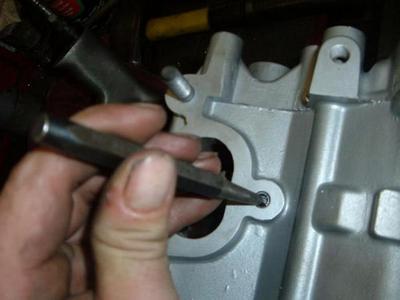
- keys;
- a screwdriver;
- pneumatic wrench;
- ratchet.
But often it is not possible to solve the problem that has arisen with the methods listed above, and then others will come to the rescue.
tools for removing broken bolts:
- Thin open-end wrenches, but they are absolutely not suitable in the case of rusty or stuck bolts, as this tears off the edges.
- Wrench.
- Box wrenches, which are more applicable, since they cover the head of the product more tightly.
- Welding equipment.
- Hexagonal box wrench, which is less likely to cause edge stripping.
- Impact pneumatic wrench.
- A multiplier that allows you to apply more force to a stuck bolt.
- Screwdriver with a large handle.
- Clamping tool.
- Extractor set.
- Hairdriver, which is perfect for products that have a high head.
Working with a set of extractors
Initially, you will need to outline the center, which requires a center punch and a hammer. A pilot hole is then drilled to be used by the extractor.
Attention!
In this case, it is important that the axis is not shifted, and the depth of this hole should be no more than three diameters of the used drill
The extractor will need to be inserted into the hole and tapped slightly to make the fixation more reliable. Only then can the tap be used to screw in the extractor. Working with it is quite simple, because after the extractor enters the product as far as it will go, the product will begin to turn inside out.
Working with welding equipment
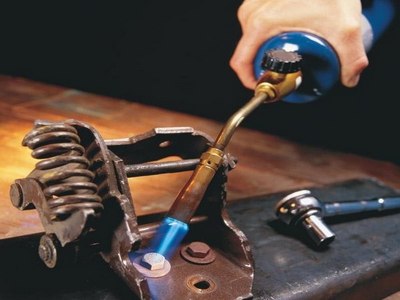 If
If
the bolt broke off, how to unscrew
it without damaging the equipment itself? The fastest way is to use welding.
To do this, take a nut of a suitable size and weld it to the broken part, but only from the inside. After that, the product can be simply unscrewed the fastener with a wrench.
Welding equipment makes it possible to unscrew a screw or bolt that has a broken head or edges torn off.
In a situation where the head is torn off, a small amount of metal must be welded onto the remaining part, then put on a regular nut and weld on it.
Unscrewing with a wrench
Unfortunately, this tool cannot be used if the head of the fastener has been torn off.
How to unscrew a licked bolt
described in another paragraph. To unscrew it with a wrench, you need to put a suitable nozzle on it. The very process of unscrewing occurs due to the impact mechanism of the wrench.
The nutrunner itself is a device that facilitates the assembly and disassembly of bolt-nut connections. It is very convenient if the wrench cannot be used.
As soon as the wrench is started, energy is supplied to the motor, transmitting energy to the gearbox, which leads to the functioning of the chuck. Almost all devices that are designed to unscrew the nuts have a special spring that allows the chuck to rotate back. This fact allows the use of a nutrunner not only in mechanical engineering, but also in many other areas of activity.
A situation often arises that
the bolt is not unscrewed, what to do
in that case, if there are no special skills? There are some simple tips to make it easier to unscrew the fastener:
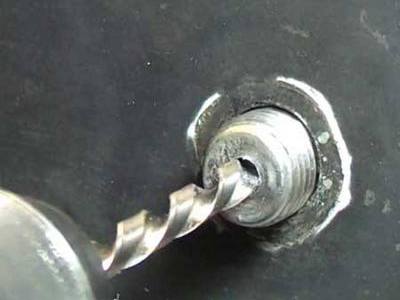
- In order to carry out this procedure faster, the element must be preheated.
-
How to unscrew a stripped thread bolt
? In this case, you can use a hex wrench. - During operation, you can use acetone or oil for lubrication.
- The use of a reverse thread drill can greatly facilitate the process.
- If no special tools are at hand, then a core and hammer can be used. To do this, the first one should be positioned at an angle of forty-five degrees and hit on it with a hammer, but only counterclockwise.
- If it is not possible to unscrew the element, then you will need to drill a larger hole and cut the threads again.
The best ways to remove rusty nuts and bolts
Let's take a closer look at the best ways to unscrew rusted parts.
The most famous and common option is to unscrew with a lever. When the bolts are rusted and they do not cope with their function of fastening, for example, a toilet bowl, this problem is solved as follows. Use a stiff bristled brush to clean the fasteners from corrosion. A piece of metal pipe is put on a box or open-end wrench and used as a lever device. Actions should be fluid. Then the mount is removed with a spanner wrench.
Dissolving rust
In car services they know how unscrew the rusted bolt using WD - 40 fluid. The agent is able to penetrate deep into gaps and reach the threads of fasteners, completely dissolving the rust structure. You need to use it like this:
- pre-shaking the liquid in a can, spray the problem area;
- wait a certain time - from 20 to 40 minutes or more, if the fasteners are large, and there is a lot of rust;
- aerosol liquid will rapidly corrode rust and help destroy oxide layers along the entire thread of the fastener;
- make vigorous movements to loosen the bolt.
Almost always, the problem is solved - the fasteners from the bolts are unscrewed. If this aerosol is not at hand, there are many other effective ways.
The heating
An affordable and easy way to unscrew rusty fasteners is by heating. Any heating device will do: a hair dryer, a soldering iron, a gas torch or a regular lighter. When heated, metal changes its structure, expands, becomes more malleable, and corrosion collapses under the influence of high temperatures:
- the mount is subjected to increased heating for several minutes, it is advisable to wait until the metal is red-hot;
- without letting the fasteners cool down, they unscrew, it is possible to use methods of loosening and tapping;
- use a socket or box wrench.
If the fasteners did not give in at the first attempt, it is recommended to try again 2-3 times. Practice shows that the bolt is unscrewed.
Breaking a nut
In especially difficult cases, when the bolt and nut do not give in in any way, experts recommend removing the nut by destroying it. With the help of a grinder, one of the edges of the nut is cut off, being careful not to damage other parts. After that, it is removed and the bolt is removed.
Good to use nut puller. Under pressure, he tightens the part, and it cracks. After that, the nut can be easily removed with a conventional wrench.
If the bolt is firmly stuck, then it is drilled with a drill in the direction from the head to the bottom. The drill diameter must match the size of the bolt. A bolt that has been emptied from the inside usually comes out on its own.
Twisting
Sometimes a situation can be dealt with by contradicting it. If you cannot unscrew rusted fasteners, for example from a toilet bowl, you need to make a few vigorous tightening efforts. Often this works, the bolt breaks off and then unscrews easily.
Tapping
There is one more tip on how to unscrew a rusty bolt - it is effective even when the threads are ripped off. First, they try to loosen the fasteners, at least slightly, this contributes to micro-fractures in the clutches of rust. Next, the bolt is covered with a soft metal extension, hit hard several times in a row with a hammer. Oxidizing compounds should collapse and crumble, and the bonded fasteners should succumb to efforts.

